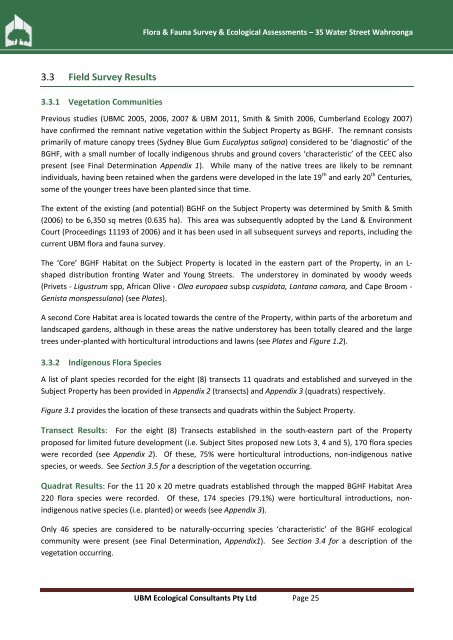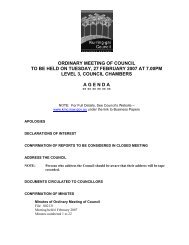Flora & Fauna Survey & Ecological Assessment (pdf. 5MB)
Flora & Fauna Survey & Ecological Assessment (pdf. 5MB)
Flora & Fauna Survey & Ecological Assessment (pdf. 5MB)
Create successful ePaper yourself
Turn your PDF publications into a flip-book with our unique Google optimized e-Paper software.
<strong>Flora</strong> & <strong>Fauna</strong> <strong>Survey</strong> & <strong>Ecological</strong> <strong>Assessment</strong>s – 35 Water Street Wahroonga<br />
3.3 Field <strong>Survey</strong> Results<br />
3.3.1 Vegetation Communities<br />
Previous studies (UBMC 2005, 2006, 2007 & UBM 2011, Smith & Smith 2006, Cumberland Ecology 2007)<br />
have confirmed the remnant native vegetation within the Subject Property as BGHF. The remnant consists<br />
primarily of mature canopy trees (Sydney Blue Gum Eucalyptus saligna) considered to be ‘diagnostic’ of the<br />
BGHF, with a small number of locally indigenous shrubs and ground covers ‘characteristic’ of the CEEC also<br />
present (see Final Determination Appendix 1). While many of the native trees are likely to be remnant<br />
individuals, having been retained when the gardens were developed in the late 19 th and early 20 th Centuries,<br />
some of the younger trees have been planted since that time.<br />
The extent of the existing (and potential) BGHF on the Subject Property was determined by Smith & Smith<br />
(2006) to be 6,350 sq metres (0.635 ha). This area was subsequently adopted by the Land & Environment<br />
Court (Proceedings 11193 of 2006) and it has been used in all subsequent surveys and reports, including the<br />
current UBM flora and fauna survey.<br />
The ‘Core’ BGHF Habitat on the Subject Property is located in the eastern part of the Property, in an L-<br />
shaped distribution fronting Water and Young Streets. The understorey in dominated by woody weeds<br />
(Privets - Ligustrum spp, African Olive - Olea europaea subsp cuspidata, Lantana camara, and Cape Broom -<br />
Genista monspessulana) (see Plates).<br />
A second Core Habitat area is located towards the centre of the Property, within parts of the arboretum and<br />
landscaped gardens, although in these areas the native understorey has been totally cleared and the large<br />
trees under-planted with horticultural introductions and lawns (see Plates and Figure 1.2).<br />
3.3.2 Indigenous <strong>Flora</strong> Species<br />
A list of plant species recorded for the eight (8) transects 11 quadrats and established and surveyed in the<br />
Subject Property has been provided in Appendix 2 (transects) and Appendix 3 (quadrats) respectively.<br />
Figure 3.1 provides the location of these transects and quadrats within the Subject Property.<br />
Transect Results: For the eight (8) Transects established in the south-eastern part of the Property<br />
proposed for limited future development (i.e. Subject Sites proposed new Lots 3, 4 and 5), 170 flora species<br />
were recorded (see Appendix 2). Of these, 75% were horticultural introductions, non-indigenous native<br />
species, or weeds. See Section 3.5 for a description of the vegetation occurring.<br />
Quadrat Results: For the 11 20 x 20 metre quadrats established through the mapped BGHF Habitat Area<br />
220 flora species were recorded. Of these, 174 species (79.1%) were horticultural introductions, nonindigenous<br />
native species (i.e. planted) or weeds (see Appendix 3).<br />
Only 46 species are considered to be naturally-occurring species ‘characteristic’ of the BGHF ecological<br />
community were present (see Final Determination, Appendix1). See Section 3.4 for a description of the<br />
vegetation occurring.<br />
UBM <strong>Ecological</strong> Consultants Pty Ltd Page 25

















